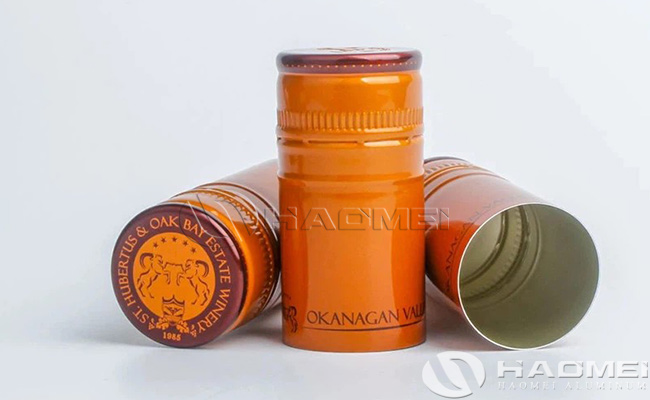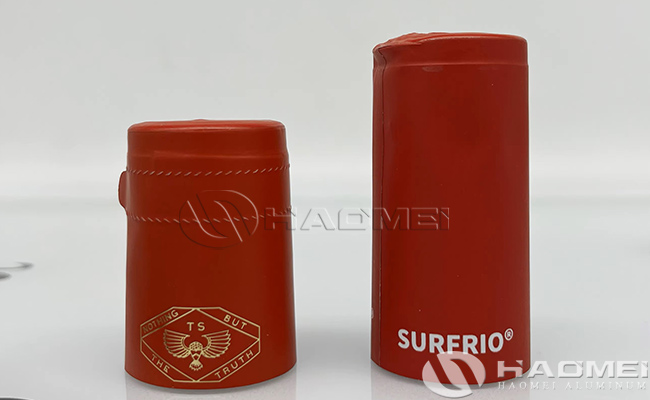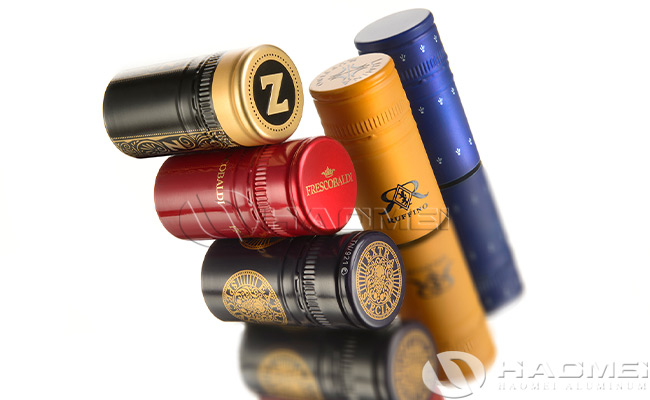Aluminum screw caps for wine bottles is a commonly used sealing component in modern wine packaging. With its convenience, sealing and environmental protection, it is widely used in various types of wine bottle packaging.

1. Structural design of aluminum wine bottle screw caps
The structural design of aluminum screw cap is centered on functionality and sealing, and is mainly composed of the following parts:
- Cap body
It is stamped from aluminum alloy sheet, cylindrical or frustum-shaped, with a flat top (brand logo or information can be printed), and a threaded structure on the side.
The material is mostly 3105 or 8011 aluminum alloy, which has good ductility and corrosion resistance.
- Thread structure
Internal or external thread (commonly internal thread), precisely matched with the bottle mouth thread, the pitch and tooth design must comply with the bottle mouth standard (such as ISO or industry specifications) to ensure sealing and labor saving when tightening.
- Anti-theft ring (tear ring)
The bottom of the cap is connected to the main body through several connecting bridges (weak points). When opened, the ring body breaks, forming an obvious anti-theft mark to prevent secondary packaging.
The number and strength of the connecting bridges need to balance the anti-theft and opening convenience.
- Liner groove / sealing structure
The inner side of the wine bottle cap is provided with a groove or boss to fix the lining material and ensure that the seal fits tightly with the bottle mouth.
2. Size specifications
The size of the aluminum screw cap is customized according to the diameter of the bottle mouth, and the common specifications are as follows:
- Diameter (mm)
Wine bottle: 70mm (standard Bordeaux bottle diameter), 63mm (some Burgundy bottles or small-diameter bottles);
White wine/spirits: 53mm, 58mm, 66mm, etc. (adjusted according to the bottle shape);
Beer bottle: 28mm, 38mm (some craft beer bottles).
- Height (mm)
Usually between 20~40mm, depending on the cap shape (such as flat top, convex top) and anti-theft ring design.
- Thread parameters
Pitch: 1.5~2.0mm (adjusted according to the bottle mouth size), the tooth angle is mostly 60° to ensure tight screwing.
3. Lining materials
The lining is the key to the sealing of the wine screw caps. The main materials are as follows:
- EPE (pearl cotton)/PE foam: soft, elastic, suitable for most wines, low cost, good sealing;
- SIP (solid injection polymer): high-density polyethylene (HDPE) or modified materials, through injection molding, precise shape, chemical corrosion resistance, suitable for high-end wines or wines that need to be stored for a long time;
- EVA (ethylene-vinyl acetate copolymer): good elasticity and weather resistance, anti-aging, suitable for environments with high humidity;
- Composite lining: multi-layer structure such as aluminum foil + PE/pulp, enhances light protection and sealing, and is used for wines that are sensitive to oxygen (such as some white wines).
4. Core Advantages of aluminum screw caps for wine bottles:
- Excellent sealing performance
Double sealing of lining material and thread structure to avoid "over-oxidation" or "cork contamination" (such as TCA odor) of traditional corks, especially suitable for wine and spirits that require a stable storage environment.
The leak-proof design is better than corks and is not easy to leak during transportation.
- Convenient opening and storage
No need for a bottle opener, just unscrew it directly, suitable for ready-to-drink scenarios; it can be re-sealed after tightening, which is convenient for the preservation of unfinished wine.
- Anti-theft and anti-counterfeiting
The anti-theft ring cannot be restored after breaking, and it can intuitively show whether the package has been opened; it can be combined with laser engraving, QR code and other technologies to enhance anti-counterfeiting.
- Environmental protection and cost advantages
Aluminum alloy can be 100% recycled to reduce resource waste; the lining material is mostly environmentally friendly plastic, which meets food contact standards;
The cost after large-scale production is lower than that of high-quality corks, and the automated packaging efficiency is high, which is suitable for industrial assembly lines.
- Strong weather resistance
Aluminum is corrosion-resistant and is not affected by humidity and temperature, which prevents corks from getting moldy or cracking due to moisture, and is suitable for transportation and storage in different climate zones around the world.
5. Application scenarios of aluminum wine bottle screw caps:
- Wine field
New World wines (such as Australian, New Zealand, and Chilean wines) use a large number of aluminum screw caps because they can accurately control oxygen permeability and avoid the uncertainty of traditional corks;
Daily consumer wines and ready-to-drink wines (such as small bottles and canned wines) prefer screw caps to improve convenience.
- Liquor and spirits
Mid- and low-end liquors, whiskeys, vodka, etc., especially focus on products that are leak-proof and easy to open during transportation;
Some high-end spirits use aluminum caps + metal plating (such as gold plating, nickel plating) to improve the packaging texture.
- Beer and fruit wine
Craft beer bottles, fruit wines, sparkling wines, etc., screw caps with pressure sealing design are suitable for carbonated beverages to prevent carbon dioxide leakage;
Portable beer (such as 330ml, 500ml bottles) often use aluminum screw caps to replace traditional crown caps.
- Other beverages and special scenarios
Medicinal wine bottles, laboratory reagent bottles (leak-proof and sealed);
Airline food, outdoor portable wine packaging, because it is easy to open and resistant to extrusion.
Through structural innovation and material optimization, the aluminum screw cap surpasses traditional packaging in terms of sealing, convenience and environmental protection, especially in line with the modern wine consumption demand for "ready-to-drink, easy to store, and standardized". With the upgrading of technology, its application in the high-end wine market has gradually expanded, becoming a typical case of the packaging industry's transformation to green and intelligent.
MESSAGE
RECOMMENDED PRODUCTS
PRODUCTS
CONTACT US
Add:Zhengzhou, Henan, China






